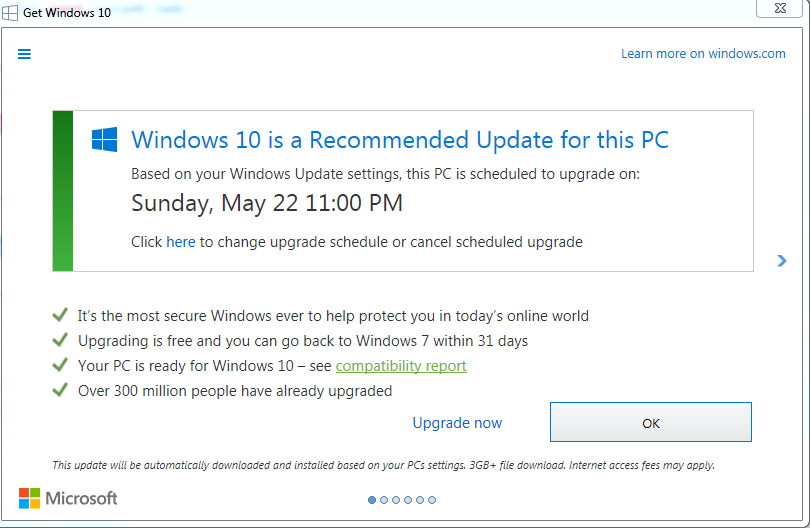Microsoft’s explanation for pushing Windows 10 upgrades raises questions
If you follow tech news sites you may have read pieces already on how Microsoft's Chief Marketing Officer, Chris Capossela explained on the Windows Weekly 497 videocast that the company is aware of that it went too far with pushing Windows 10 upgrades to customer systems.
The press, for the most part at least, saw Capossela's comments on the issue in positive light. You can check out the Softpedia article for instance to get a feel for the vibe Capossela's commenting on pushing Windows 10 upgrades caused.
Lets take a look first at what Capossela said (this begins at around 17:40):
And then the last one for me, purely from a marketing or branding perspective [..] was getting to aggressive in pushing out the free Windows 10 upgrade.
We know we want people to be running Windows 10 from a security perspective, but finding the right balance where you’re not stepping over the line of being too aggressive is something we tried and for a lot of the year I think we got it right, but there was one particular moment in particular where, you know, the red-X in the dialog box which typically means you cancel didn’t mean cancel.
And within a couple of hours of that hitting the world, with the listening systems we have we knew that we had gone too far and then, of course, it takes some time to roll out the update that changes that behavior. And those two weeks were pretty painful and clearly a low-light for us. We learned a lot from it obviously.
This explanation raises more questions than it gives answers. Yes, it is sort-of an apology if you look at it.

The question that Paul, Mary Jo or Leo Laporte should have asked right after Capossela finishing the last sentence is how on earth anyone at Microsoft could think it would be a good idea to change the functionality of the red-X function in the upgrade window.
Extreme Tech's Joel Hruska puts it quite well in stating that Microsoft at the time either thought that changing core Windows functionality would not go too far in pushing the Windows 10 upgrade, or that the company has a serious issue when it comes to -- internal -- criticism of issues (read complains were ignored by executives).
Anyone, with some experience on Windows, and I think Microsoft employees and executives working on Windows have that, should have realized immediately that changing the close functionality of the Get Windows 10 upgrade window to "ok" would be disingenuous and borderline malicious.
Microsoft only had to look at the company's own Windows Dev Center guide on dialog boxes to know that this is wrong:
The Close button on the title bar should have the same effect as the Cancel or Close button within the dialog box. Never give it the same effect as OK.
And that is not even taking into account the previous iterations of the Get Windows 10 Upgrade experience which Microsoft made harder and harder to refuse and ignore.
The second question that should have been asked is why it took Microsoft weeks to undo this particular update. Why did not Microsoft roll back the previous version of the Get Windows 10 upgrade tool instead? This could probably have been done in less than a day after noticing that user complaints skyrocketed.
It would also have been interesting to get Microsoft's reaction on the fallout on "pushing windows 10 too aggressive". Yes, the company got users to upgrade to Windows 10 in large numbers. Some did so willingly, others because they could not stop the upgrade from taking place.
But there is also a part of the company's customer base that Microsoft scared of with its tactics. Long-time Microsoft customers who don't want anything to do with Windows 10 because of how aggressive Microsoft was in pushing Windows 10 to customer devices. The whole privacy and update situation on Windows 10 adds to that.
Some of these customers will probably never upgrade to Windows 10 which means that Microsoft's campaign did lose the company customers as well.
Woody over on Ask Woody thinks this is a major factor that is affecting Windows 10 adaption:
The “Get Windows 10” campaign has done more to destroy Microsoft’s reputation than anything I’ve encountered – and I’ve been writing books about Microsoft products for almost 25 years. The current slump in Win10 adoption, in my opinion, can be traced directly to Microsoft’s heavy-handed jackboot GWX approach.
Closing Words
It is clear to everyone that Microsoft went too far with the Get Windows 10 upgrade campaign. I called Microsoft out for using malware-like tactics to spread Windows 10, and I was not the only one who did that.
Why did Microsoft do it this way? The question is, would not have the free offer been enough to get users to upgrade to Windows 10? Usage numbers would not be as high after the one-year free upgrade period of course, but playing it nice would have avoided burning bridges to existing customers who felt that Microsoft was getting too aggressive in its attempt to get them to upgrade to the new operating system.
Reception would probably have also been better from a marketing perspective, considering that tech sites would not have written piece after piece complaining about Microsoft's upgrade strategy.
Anyway, what is done is done. I'm not sure if Microsoft learned a thing from the whole debacle. Probably not.
Now You: What's your take on this?
This article was first seen on ComTek's "TekBits" Technology News

- Log in to post comments